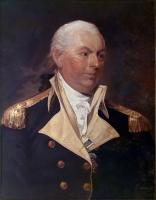
John Barry by Gilbert Stuart 1801
This seems like a good day to celebrate birthdays. A repost from two years ago.
Happy birthday to Commodore John Barry, born on this day in 1745, in Tacumshane, County Wexford, Ireland. He is considered by many to be the “father of the United States Navy.” But wait, isn’t John Paul Jones also considered to be the “father of the United States Navy?”
As the saying goes, success has many fathers. Over the years, the birthday of the US Navy has been celebrated on at least four different dates. Likewise five different cities and towns lay claim to its birthplace. So, perhaps it is not surprising that the Navy has more than one candidate as father.
While John Paul Jones is far more famous, John Barry was in many respects the superior naval commander. Once could argue that much of John Paul Jones’ fame is due to Theodore’s Roosevelt’s need for a naval hero to persuade Congress to fund a new fleet of battleships at the turn of the 20th century. But that is another discussion.
John Barry was born in 1745 at Ballysampson on Our Lady’s Island, which is part of Tacumshin Parish in County Wexford, Ireland. The son of a poor tenant farmer evicted by his British landlord, Barry went to sea at an early age as a cabin boy on his uncle’s fishing boat. In an era when the average male height was around 5’5″, John Barry was a towering 6’4″ with a strong build and a ruddy complexion.
At 17, Barry emigrated to Philadelphia where he sailed as mate on trading ships. At 21, he was given his first command, the schooner, Barbadoes, sailing in the West Indies trade. He was a successful merchant captain and was given progressively larger vessels to command. In 1774, he was made captain of the Black Prince, owned by Thomas Willing and Robert Morris.
With the start of the American revolutionary war, the Black Prince was purchased by the Continental Congress for use as a man-of-war. The ship was renamed Alfred. Barry supervised much of the conversion, before taking command of the brig Lexington. In the Lexington, Captain Barry captured the first British ship at sea of the war and went on to capture other prizes in his year long command, while avoiding the British blockade.
Barry would go onto command both privateers and Continental Navy vessels including the Delaware, Raleigh, and Alliance. When between naval commands Barry organized a company of volunteers which assisted Washington in crossing the Delaware, and took part in the battles at both Trenton and Princeton. He would also lead 27 men in rowboats in boarding British transports ship in the Delaware River at Philadelphia, seizing three ships, many tons of supplies and over 100 British soldiers.
In command of the Alliance, Barry captured numerous prizes including the privateers Alert, Mars and Minerva. He also defeated the Royal Navy ships Atlanta and the Trepassy. During the engagement with the Atlanta. In the last naval engagement of the war, Barry defeated the HMS Sybylle.
After the end of the war, Captain Barry commanded the merchant ship Asia in the beginning of the China trade.
When the new United States Navy was organized in 1794, Captain Barry commanded the frigate United States in the Quasi-War with France. In 1797, Barry was issued Commission Number 1 by President George Washington, backdated to June 4, 1794. His title was thereafter “commodore.” He is recognized as not only the first American commissioned naval officer but also as its first flag officer. Barry’s last day of active duty was March 6, 1801, when he brought the USS United States into port. He remained head of the Navy until his death on September 12, 1803 at the age of 58.

Pingback: Maritime Monday for March 27th, 2017 – gCaptain
If not already convinced that he is entitled to be called, “Father of the U.S. Navy”, read the stirring and impressive “JOHN BARRY–American Hero in the Age of Sail,” by Tim McGrath.
Pingback: New York History Around The Web This Week | The New York History Blog